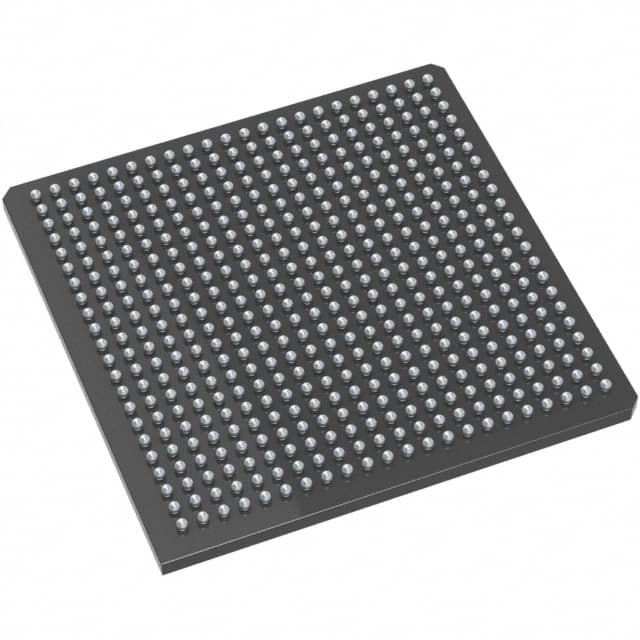M2GL025-FG484
Product Overview
Category
M2GL025-FG484 belongs to the category of Field-Programmable Gate Arrays (FPGAs).
Use
This product is primarily used for digital logic implementation and prototyping in various electronic systems.
Characteristics
- M2GL025-FG484 offers high flexibility and reconfigurability, allowing users to modify the functionality of the device even after it has been manufactured.
- It provides a large number of programmable logic elements, memory blocks, and I/O pins, enabling complex digital designs.
- The FPGA supports various communication protocols and interfaces, making it suitable for diverse applications.
- It offers fast processing speeds and low power consumption, enhancing overall system performance.
Package
The M2GL025-FG484 comes in a Fine-Pitch Ball Grid Array (FG484) package.
Essence
The essence of M2GL025-FG484 lies in its ability to provide a customizable hardware platform that can be tailored to specific application requirements.
Packaging/Quantity
Each package contains one M2GL025-FG484 FPGA.
Specifications
- Logic Cells: 25,000
- Block RAM: 1,080 Kbits
- DSP Slices: 80
- Maximum User I/Os: 316
- Operating Voltage: 1.2V
- Operating Temperature Range: -40°C to 100°C
- Package Dimensions: 23mm x 23mm
Detailed Pin Configuration
The M2GL025-FG484 FPGA has a total of 316 user I/O pins, which are configurable based on the desired functionality. These pins are distributed across the four sides of the package, with each side accommodating a specific number of pins.
For a detailed pin configuration diagram, please refer to the manufacturer's datasheet.
Functional Features
- High-speed data processing capabilities
- Support for various communication protocols (e.g., UART, SPI, I2C)
- On-chip memory blocks for efficient data storage and retrieval
- Flexible clock management resources for precise timing control
- Built-in digital signal processing (DSP) slices for complex mathematical operations
- Configurable I/O standards to interface with different voltage levels
Advantages and Disadvantages
Advantages
- Flexibility and reconfigurability allow for rapid prototyping and design iterations.
- High-performance computing capabilities enable the implementation of complex algorithms.
- Low power consumption contributes to energy-efficient system designs.
- Wide range of available I/O pins facilitates connectivity with external devices.
- Compatibility with various development tools and software frameworks simplifies the design process.
Disadvantages
- Steep learning curve for beginners due to the complexity of FPGA programming.
- Higher cost compared to traditional fixed-function integrated circuits.
- Limited availability of alternative models from other manufacturers.
Working Principles
The M2GL025-FG484 FPGA operates based on the principle of configurable logic. It consists of an array of programmable logic elements interconnected through configurable routing resources. These logic elements can be programmed to implement desired digital functions using a Hardware Description Language (HDL) or graphical design tools.
Upon configuration, the FPGA's internal connections are established, allowing data to flow between different logic elements. The device can be reprogrammed multiple times to modify its functionality as required.
Detailed Application Field Plans
The M2GL025-FG484 FPGA finds applications in various fields, including:
- Telecommunications: Used in base stations, network switches, and routers for high-speed data processing and protocol handling.
- Industrial Automation: Employed in control systems, motor drives, and robotics for real-time control and signal processing.
- Aerospace and Defense: Utilized in radar systems, avionics, and military communication equipment for high-performance computing and signal analysis.
- Medical Electronics: Integrated into medical imaging devices, patient monitoring systems, and diagnostic equipment to process and analyze data.
- Automotive: Incorporated in advanced driver-assistance systems (ADAS), infotainment systems, and engine control units (ECUs) for enhanced functionality and performance.
Detailed and Complete Alternative Models
While the M2GL025-FG484 is a highly capable FPGA, alternative models from other manufacturers are also available. Some notable alternatives include:
- Xilinx Spartan-6 XC6SLX25
- Intel Cyclone IV EP4CE25
- Lattice Semiconductor iCE40UP5K
These alternatives offer similar features and capabilities, providing users with a range of options based on their specific requirements.
In conclusion, the M2GL025-FG484 FPGA offers high flexibility, performance, and reconfigurability, making it suitable for a wide range of applications across various industries. Its ability to implement complex digital designs and support diverse communication protocols makes it a valuable tool for electronic system development.
10个与M2GL025-FG484在技术解决方案中的应用相关的常见问题及解答
Sure! Here are 10 common questions and answers related to the application of M2GL025-FG484 in technical solutions:
Q: What is M2GL025-FG484? A: M2GL025-FG484 is a specific model of field-programmable gate array (FPGA) manufactured by a company called Microsemi.
Q: What are the key features of M2GL025-FG484? A: Some key features of M2GL025-FG484 include 25,000 logic elements, 1,080 Kbits of embedded memory, and 270 user I/O pins.
Q: What is the typical power consumption of M2GL025-FG484? A: The typical power consumption of M2GL025-FG484 is around 0.5 Watts when operating at room temperature.
Q: Can M2GL025-FG484 be used for high-speed data processing applications? A: Yes, M2GL025-FG484 is capable of handling high-speed data processing due to its advanced architecture and high-performance capabilities.
Q: Is M2GL025-FG484 suitable for industrial control systems? A: Absolutely, M2GL025-FG484 is commonly used in industrial control systems due to its reliability, flexibility, and ability to interface with various sensors and actuators.
Q: Can M2GL025-FG484 be programmed using industry-standard design tools? A: Yes, M2GL025-FG484 can be programmed using popular design tools such as Xilinx Vivado or Intel Quartus Prime.
Q: Does M2GL025-FG484 support communication protocols like Ethernet or USB? A: Yes, M2GL025-FG484 supports various communication protocols, including Ethernet, USB, SPI, I2C, and UART.
Q: Can M2GL025-FG484 be used in safety-critical applications? A: Yes, M2GL025-FG484 can be used in safety-critical applications as it offers features like error detection, redundancy, and fault tolerance.
Q: What is the temperature range within which M2GL025-FG484 can operate reliably? A: M2GL025-FG484 has a wide operating temperature range of -40°C to 100°C, making it suitable for both industrial and automotive applications.
Q: Are there any development boards or evaluation kits available for M2GL025-FG484? A: Yes, Microsemi provides development boards and evaluation kits specifically designed for M2GL025-FG484, allowing engineers to prototype and test their designs easily.
Please note that the answers provided here are general and may vary depending on specific requirements and use cases.


